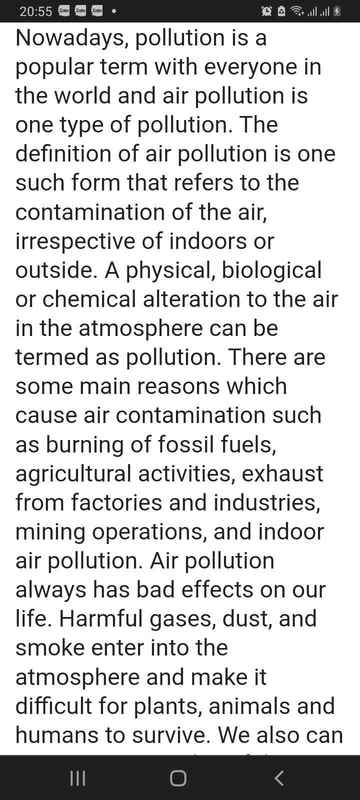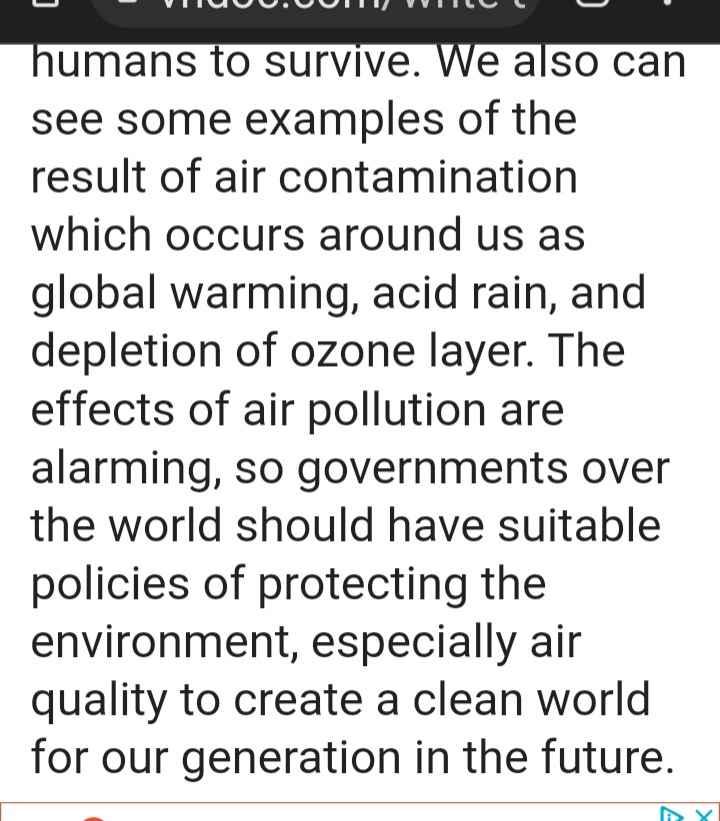writing about a type of pollution in your area.

Những câu hỏi liên quan
Imagine that you two are writing an article for the local newspaper about a type of pollution in your area. One of you writes about the causes and the other writes about the effects of the pollution type you have just discussed in 3.
4. Imagine that you two are writing an article for the local newspaper about a type of pollution in your area. One of you writes about the causes and the other writes about the effects of the pollution type you have just discussed in 3.
Nowadays, one of the biggest problems human are facing with is water pollution. Water pollution is defined as the presence in groundwater of toxic chemicals and biological agents that exceed what is naturally found in the water and may pose a threat to human health and/or the environment. A lot of causes are responsible for this issue. And they lead to extremely bad consequences. I’d like to explain more in the following paragraphs.
Some typical causes of water pollution are Industrial waste, Sewage and waste water, Mining activities, Accidental Oil leakage, Burning of fossil fuels, Chemical fertilizers and pesticides, … These agents contribiute to water pollution.
And the consequences? Of course, it is human health! Human are likely to get into trouble with some diseases such as hepatitis by eating seafood that has been poisoned. Water pollution also brings about the death of aquatic (water) animals, Disruption of food-chains, Destruction of ecosystems.
In conclusion, water pollution is a alarming problem that needs to be solved as soon as possible. The sooner we solve it, the more healthy we are.
Đúng 0
Bình luận (0)
Writing an articla about the causes and effects of one type of pollution in your area , and also
Write about a type of pollution in your area. (about 100 words)
Refer
Air pollution: Definition: air pollution is a mixture of solid particles and gases in the air. CAuse: have a two main cause : The first is from nature as acid rain. The second is from people acting as vehicles emitting dust and smoke. Effect:harmful to humans , making animals and plants unable to live, causing serious illness. Sollution: planting trees, improve human working machines, educating people on mesures to raise awareness of environmental protection
Đúng 3
Bình luận (0)
talk about a type of pollution in your area
Air pollution is a major change in the composition of the atmosphere, mainly from smoke, dust, soot, steam or air makes strange gas is not clean, there was a smell coming, reduced visibility, caused climate change, pathogenic for humans and creatures.
Air pollution caused more than 3 million people die prematurely every year, it threatens virtually all of the big city dwellers in the developing countries. According to Fox News 80% of cities in the world can not meet the standards of the World Health Organization on air quality, which is mainly concentrated in poor countries. WHO said the level of urban air pollution worldwide has increased by 8% despite improvements in some areas. This leads to the risk of stroke, heart disease, lung cancer and a variety of respiratory problems.
Xin 1 ticks . Thanks
Đúng 0
Bình luận (0)
imagine that you're writing an article for the local newspaper about causes and effects of a type of pollution in your area. Write your article about that!
Length:100-150 words
Mong các bạn giúp mình cái ạ :)
Tham khảo :
Air pollution is a major change in the composition of the atmosphere, mainly from smoke, dust, soot, steam or air makes strange gas is not clean, there was a smell coming, reduced visibility, caused climate change, pathogenic for humans and creatures.
Air pollution caused more than 3 million people die prematurely every year, it threatens virtually all of the big city dwellers in the developing countries. According to Fox News 80% of cities in the world can not meet the standards of the World Health Organization (WHO) on air quality, which is mainly concentrated in poor countries. WHO said the level of urban air pollution worldwide has increased by 8% despite improvements in some areas. This leads to the risk of stroke, heart disease, lung cancer and a variety of respiratory problems.
Write a paragraph (about 80 – 100 words) about “A type of pollution in your area”.
Air pollution: Definition: air pollution is a mixture of solid particles and gases in the air. CAuse: have a two main cause : The first is from nature as acid rain. The second is from people acting as vehicles emitting dust and smoke. Effect:harmful to humans , making animals and plants unable to live, causing serious illness. Sollution: planting trees, improve human working machines, educating people on mesures to raise awareness of environmental protection
Đúng 0
Bình luận (0)
Write a short paragraph 140-160 words about a pollution in your area. Your paragraph should include type of pollution definition, cause , effects , prevention .
p/s: cacban đừng sử dụng quá nhiều từ dài và khó nhé ( chủ yếu là áp dụng vocab lớp 8 or 9 )
Parallel about develop society, our environment is becoming bad to worse. In old times, people lived in a fresh environment so they can live so strong until die. But now, people always have many sick from mild to heavy. Do you think why? Because many people were lost sense of protection, littering indiscriminately, deforestation too much,... Don't get too late, right now we can grow more trees, punish acts polluting the environment,...Let's live more meaning
Đúng 1
Bình luận (2)
1. Write about a natural disaster you have read about.
2. Write a passage describing the schedule for your visit (Choose 4 activities that you would like to do in a 2 day visit to Washington D.C., the capital of the USA.)
3. Write about the causes and effects of one type of pollution in your area
1. Write about a natural disaster you have read about.
The most destructive disaster that I have experienced was the flood in 2012, in Thanh Hoa province. It had been raining heavily for many days. All homes, trees and animals were flooded. The water got to the roof of houses. Damage was caused to property and people. Many people were injured and died. Rescue workers helped people trapped in the flooded houses and they brought people who were left homeless to safe place. My house was flooded but we had been evacuated before. Although the time has gone by, I still can’t forget that terrible disaster.
Đúng 3
Bình luận (0)
2. Write a passage describing the schedule for your visit (Choose 4 activities that you would like to do in a 2 day visit to Washington D.C., the capital of the USA.)
This is the schedule for our group’s 2-day visit to Washington DC. On the first day, we plan to expore the city on a hop-on-hop-off trolley at 9 am. Then at 1: 00 we are visiting the White house , where the President of the USA lives. On the second day, we are taking the shuttle bus to visit the National Children’s museum at 8:00. Then at 14-00 we plan to cycle on bike trails in Nationa park.
Đúng 0
Bình luận (0)
3)
Water pollution has become a growing concern over the last century as more and more waste is being disposed of in our oceans, rivers and lakes.
This increase in pollution is harming our food supplies, drinking water and environment.
It is also creating issues in the oceans ecosystem and hurting the animals and plant life that rely on the ocean and rivers for their survival.
This article will provide you with an in depth explanation of what water pollution is, the causes and effects associated with water pollution and what can be done to prevent or even reverse the condition of water pollution.
WHAT IS WATER POLLUTION?
Water pollution is caused by the intentional or unintentional release of toxic chemicals/materials, contaminants and harmful compounds into various bodies of water such as rivers, lakes and the ocean.
Without proper disposal or filtration of these pollutants they can spread throughout the water and effect all living animals and organisms that come into contact with it by contaminating any living thing that requires water for survival.
In addition to harming animals water pollution can also affect plants, trees, the soil and other natural materials and resources of the earth.
WATER POLLUTION CAUSES, EFFECTS AND CONSEQUENCES
Water pollution may be caused by any hazardous substance or material that makes contact with the earths water supply.
This may include oil from oil tankers and oil refineries, garbage from construction sites, city streets and residential lawns, improper disposal of hazardous materials from garbage disposal companies, chemical spills and improper chemical disposal, sewage leaks and agricultural runoffs just to name a few.
Water pollution is generally caused by human actives but may also be caused by natural resources.
When water is polluted it is usually defined as either being polluted from point sources or non point sources.
Point source pollution occurs from a specific location by a single source such as a large factory, oil refinery or hauling ship that contributed a massive amount of pollution within a single area.
This large scale pollution can then be spread across large bodies of water affecting many miles of water, agricultural land, animal habitats and oceanic ecosystems.
Non point source pollution can occur from many different areas that all contribute to a body of water.
This can occur from large neighborhoods with poor residential lawn quality from sewage leaks and other types of contaminants, city streets where garbage and chemicals are not disposed of properly and large agricultural areas that use harmful chemicals which runoff into a body of water and contribute to other sources of water pollution.
When people rely on a specific body of water for drinking, cleaning and other purposes and that water becomes polluted it can become a major issue.
Once water becomes polluted it becomes unsafe for consumption due to the dangerous or toxic materials that are contained within the water.
If contaminated water is consumed it could lead to sickness, infections, exposure to diseases and even death.
While pollution is a growing concern determining what water is polluted isn’t always easy when observed by the naked eye or our taste buds.
Water may appear to be clean for consumption however it may have hidden pollutants that can affect our bodies as well as animals, plants and various other organisms.
In order to determine the health of water (especially clear, clean looking water) researchers and scientists often need to perform special tests.
If the water is considered contaminated it will need to go through a filtration and removal process before it can become drinkable or even sustainable for numerous animal species that inhibit that body of water.
Sadly the issue of water pollution is even more severe in third world countries where there is no way to properly dispose of poisonous chemicals/materials and polluted water cannot easily be cleaned or treated.
In these countries people often end up reusing polluted water which can lead to many of the issues described previously such as birth deformities, sickness, disease and death.
In addition to being affected by water pollution these countries do not have the medical staff or antibiotics necessary to deal with those who become sick and ill from water pollution.
Finding a way to develop cheap filtration systems and better waste disposal management systems is going to be a vital step towards improving the health of our drinking water and the bodies of water that surround us.
These are a few of the most common causes and effects of water pollution:
Causes of water pollution
1) Water pollution may be caused by the intentional or unintentional disposal of hazardous chemicals and materials into a body of water.
2) Rainfall may cause polluted landscapes to disperse their poisonous materials into the water and poison the surrounding water.
3) Water pollution may also be caused by specific points or contributing factors such as large factories, oil refineries, construction sites, chemical waste management facilities, dump sites and other large scale operations that store/produce large amounts of chemical/hazardous waste.
Effects of water pollution1) Toxic rainfall can occur in areas where water and/or air is polluted with toxic chemicals and materials.2) Polluted water can lead to sickness, disease, infections, deformities and even death among animals and plant life.3) Once water becomes polluted it can affect people and animals either directly through consumption or indirectly through food sources, land degradation and the overabundance of plants and algae which can cover the surface of various bodies of water making it undrinkable and affecting the animals that live in that body of water.
As you can see there are a number of different factors that can contribute to the ongoing issues we are facing with water pollution.It not only harms us and the land we live on, it also affects animals and the oceans ecosystem.
WATER POLLUTION, ANIMALS AND THE ECOSYSTEM
As stated earlier in addition to being harmful to humans water pollution also plays a big factor in the survival of animals, plant life and various ecological factors.
Animals and plants may be even more affected by water pollution than humans and land dwelling animals, especially those that live in and around the ocean such as fish and marine mammals like whales.
Water pollution may either affect the animal directly such as in the case of fish that rely on clean water to pull oxygen from and indirectly by affecting algae growth which limits the amount of sunlight that can penetrate the water.
In the case of whales and other marine mammals they may either be affected through cuts or wounds that allow the poisonous water to enter their flesh and blood stream or through the prey they consume such as fish.
Fish, marine birds and other oceanic animals that have been affected by pollution have been known to become sick, diseased and in some cases born with deformities.
Furthermore once these animals are poisoned they are no longer safe for human or animal consumption.
Species that consume poisoned food may be affected by the same factors as the poisoned fish/prey they consume.
In regards to plant life algae and other organisms may experience overgrowth or abnormalities that can affect the suns ability to shine through the water further preventing the water from being clean and minimize ability of fish and other gill bearing animals to extract clean oxygen from the water.
MINIMIZING WATER POLLUTION AND IMPROVING THE ENVIRONMENT
In order for countries to keep their water clean and uncontaminated there are a number of factors that can be implemented to insure that the water on our earth remains clean and if contaminated can be filtered so that the poisonous materials can be removed.
For beginners factories, construction sites, chemical waste facilities and other large buildings that create large amounts of pollution should make sure that their waste is being disposed of properly.
Proper disposal/containment of toxic chemicals/materials before they have an opportunity to reach our oceans and lakes would go a long way towards improving the current condition of our water.
Second, by implementing renewable energy sources to run these large operations companies can obtain their energy from eco-friendly sources that do not harm or pollute the atmosphere.
For example solar energy, wind turbines and hydro power are all pollution free methods of obtaining power from the earths natural resources without harming the earths existing natural resources to obtain this energy.
Third, eco-friendly chemicals should be used to replace toxic cleaning chemicals, sprays and other supplies.
These chemicals are extremely helpful as they do not contaminate the water they come into contact with so if they go down a drain pipe or sewage drain there is little or at least less negative consequence.
With that said even eco-friendly chemicals should be disposed of properly and with caution.
Fourth, toxic fumes created from industrial zones should be filtered, rerouted and cleaned before making their way to the atmosphere.
In fact the use of renewable energy sources can help eliminate the creation of toxic fumes and provide better airflow.
Toxic fumes may also contribute to water pollution as they can be carried to different areas by the wind and heavy rainfall can help spread the toxic debris into various water systems.
Fifth, companies that develop products and goods should focus on developing materials that are eco-friendly and recyclable.
The more recyclable components their are in the products they sell the better it is for the environment and by allowing people to reship or resell the old materials companies can save money by reusing the parts that they obtain.
Sixth, reduce, recycle & reuse. Companies can find better ways to reduce the amount of materials they use to create their products, recycle left over materials and reuse or re-purpose materials that may not work with their existing products.
These are just some of the steps companies and organizations that produce toxic waste and pollutants can take to reduce the amount of pollution that hits our waters.
HOW YOU CAN HELP
If you would like to limit the amount of pollution you produce and thus help keep the oceans, rivers and lakes clean there are a number of things you can do.
Keep your car well maintained and immediately service it if you notice any oil leaking from the car
Replace your air fresheners with eco-friendly candles, incense and/or potpourri
Purchase environmentally friendly cleaning products that do not harm the land if they happen to be flushed or emptied into a drain
Reduce the amount of power you use and purchase energy saving light bulbs and appliances. This helps reduce the amount of emissions being released by utility companies and your own home products.
Conserve your water usage and don’t leave water running when you are not using it
Reduce, recycle & reuse materials that you have purchased. Plastics and papers may be sent to the recycling bin while some of your glass materials may be able to be reused or re-purposed
Make sure non recyclable waste is contained properly so that it does not spill into the land, street drain sewage drain
Purchase local food that has been grown from healthy agricultural farms that don’t use polluting fertilizers and pesticides
Purchase eco-friendly lawn fertilizers and pesticides for your own lawn in order to prevent your lawn from becoming toxic and prevent possible hazardass chemicals from entering street drains
Recycle old clothing by giving it away to shelters and non for profit re sellers. Not only does it lower the amount of garbage you produce it also allows you go give to a cause and help the community
Use a reusable grocery bag rather than the plastic bags offered at grocery stores when shopping for food to minimize your plastic waste
Eliminate unnecessary mail and have your bills sent to you by email. This helps protect the trees and reduce the amount of paper you have to dispose of later
Properly dispose of toxic chemicals rather than dropping them down the drain. You can do an online search for local toxic chemical disposal areas near you
As you can see there are a lot of things you can do to help reduce the amount of pollution you produce.
Even if you only implement a few of these strategies you could end up reducing a ton of waste and unnecessary garbage that is created in daily life.
10 THOUGHT PROVOKING FACTS ABOUT WATER POLLUTION
1) Over half a billion people live in areas where they consume and rely on polluted water for their survival
2) Large ships such as transportation vessels and cruise ships are a large contributers to the current condition of water pollution
3) Many of today’s fertilizers and pesticides carry toxic chemicals that can spill into the ocean, sewage drains, lakes and rivers harming marine life and the animals that drink the water
4) Only 3% of the worlds water is considered freshwater
5) Locations such as Bangladesh, India and China are suffering from high levels of water pollution with limited options for disposing of toxic chemicals/materials which threaten the lives of the people living in these areas
6) The majority of freshwater is found in lakes, rivers, ice and glaciers
7) Poorly contained toxic materials such as garbage, fertilizer and poisonous chemicals can be picked up by the rain or running water and make its way into local rivers, lakes and the ocean without being treated or filtered
8) The same chemicals used to keep our homes clean and maintain our automobiles are highly toxic and can find there way into our water systems of not disposed of properly
9) It is estimated that as many as 100,000 marine mammals are killed every year by pollution
10) In areas that are highly polluted the opportunities of getting lung cancer, heart disease and other life threatening ailments is significantly higher
SEARCH
SEARCH THIS WEBSITE …
SEARCH
TRENDING
Water Pollution Facts, Causes, Effects & Solutions
Killer Whale Follows Your Mouse Cursor
What Do Whales Mean In Dreams?
Blue Whale Facts
Killer Whale Facts
Whale Adaptations
Why Are Blue Whales Endangered?
Dolphin Facts and Information
Why Are Whales Important?
Humpback Whale Facts
Đúng 0
Bình luận (0)

























